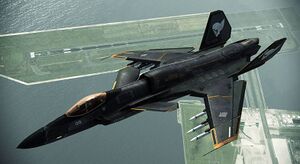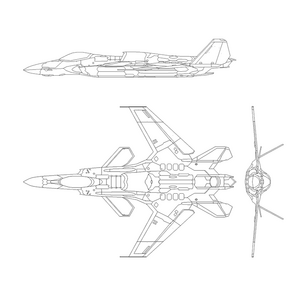NSF-14 Colibri Strike Fighter
| Casati NSF-14 Colibri | |
|---|---|

| |
| A Colibri painted in Blackhawk Squadron colors during the SAF international air show. | |
| Role | Multirole fighter aircraft |
| National origin | |
| Manufacturer | Casati Aircraft Corporation |
| First flight | 13 March 2009 |
| Introduction | 19 June 2014 |
| Status | In active service |
| Primary user | |
| Produced | 2014—Present |
| Number built | 120 |
| Unit cost |
ɫ106,220,000
|
The Casati NSF-14 Colibri (Hummingbird) is a single-engine, fifth-generation, all-weather, forward-swept wing, carrier-capable supersonic jet fighter developed by Casati Aircraft Corporation for the Cacertian Royal Navy. It is characterized by its excellent agility and maneuverability in comparison to previous Cacertian fighter aircraft. The first prototype was completed and made its first flight in 2009. After extensive design fine-tuning, it entered service with the Royal Navy and Royal Air Fleet in 2014.
The Colibri’s key features include a frameless bubble canopy, side-mounted control stick, and a combination of relaxed static stability and fly-by-wire flight controls. With a top speed of Mach 2.2, the Colibri is currently the fastest and the most maneuverable multirole carrier fighter in service with Cacerta. It is capable of carrying a multitude of different bombs and missiles that allow it to fulfill a wide array of air-to-air, air-to-ship, and air-to-ground missions.
It is expected to replace the NSF-12 and NSF-13 as the Royal Navy’s primary strike fighter and is currently the main aircraft of the CRN’s elite Blackhawk Squadron. The Colibri first saw combat action during the Cacertian Intervention in the Nalayan Civil War.
Development
Development of the NSF-14 began in 1990 as part of the Royal Navy’s Next Generation Carrier Fighter (NGCF) program and was conducted in parallel to the Ossor-Cacertian Joint Next Generation Fighter (JNGF) project. Although the JNGF program did result in the creation of the Ossorian carrier-capable F-39 Raven, the Royal Air Fleet’s parameter that the Cacertian fighter be stealth led to numerous delays. The Royal Navy eventually withdraw from development and pressed forward with several concepts that had been previously presented to them by the Casati Aircraft Corporation.
As Ersilia was effectively tied developing what would become the AFASF-14, they were unable to participate or submit a design for the NGCF program leaving Casati as the sole designer and developer. The program contract was signed on 13 January 1994 with the experimental designation of PN-14. Although the PN-14 originally started off as a traditional configuration aircraft, this was later switched to the more unique forward-swept wing design by the end of 1998.
CAC had briefly experimented with forward-swept wing aircraft in the late 1970s and early 1980s, but abandoned the project due to cost and a lack of a dedicated budget. Their previous experience, however, did yield important results that would later be used in the design of the PN-14. Model tests revealed that forward-swept wings yielded higher maximum lift, significantly reduced stress on an airframe, and delayed stalling in comparison to more traditional designs. This granted higher angles of attack and increased aileron control.
The first prototype PN-14 was completed on 3 March 2009 and made its first flight ten days later. Following the completion of its first trial runs, the program was officially designated NSF-14 with serialized production aimed for early to mid-2014. The official nickname given to the fighter, Colibri, is in direct reference to the aircraft’s nimble performance. The NSF-14 is unusual in that no two-seat trainers were built as a result of the development of new and advanced flight simulators.
Design
The NSF-14 is a single-engine, highly-maneuverable multirole tactical fighter capable of maintaining around-the-clock readiness and making it unlike any other fighter currently in service with the Kingdom. It is much smaller and lighter than its predecessors, purpose-built for 9-g maneuvers, a maximum speed of over Mach 2, and is easily distinguishable for its unorthodox appearance. It possesses a reduced radar signature, an internal weapons bay, and advanced radar systems. To help address the issue of increased wing-twisting due to the aircraft's design, the NSF-14 is constructed using composite materials.
The advanced systems of the NSF-14 allows the Colibri to conduct operations both during the day and at night in any manner of adverse weather conditions. It is also equipped with an in-flight refueling probe. The high maximum take-off weight of the Colibri as well as its larger fuel stores allow it fly significantly further than its NSF-12 and NSF-13 predecessors both at altitude and at sea level.
Although all currently active carriers in the Cacertian Royal Navy often use CATOBAR for launching their aircraft complement, the forward-swept wing design allows the Colibri to perform rolling takeoffs on carrier decks in the event a ship’s CATOBAR system fails. Unique to its design, the Colibri has extremely high agility at subsonic speeds and can quickly alter its angle of attack. The design also allows the Colibri to alter its flight path utilizing its maneuverability at supersonic speeds. Thrust vectoring also supports the NSF-14's already impressive agility.
Production
Entering serialized production in 2014, the first NSF-14 were granted to the Royal Navy and stationed aboard the recently completed HMS Mariella Bianchi, a Duchess Mariella class aircraft carrier commissioned in 2011. They are expected to be produced for the next several years to meet demand from both the Navy and the Royal Air Fleet.
Production Figures
Since they entered production in 2014, a total of 120 NSF-14s have been issued for service.
Operational History
The NSF-14 saw combat during the Nalayan Civil War.
Specifications
General Characteristics
- Crew: 1
- Length: 15.06 m (49 ft 5 in)
- Wingspan: 13.9 m (45 ft 6 in)
- Height: 4.5 m (14 ft 10 in)
- Wing Area: 81.6 m² (878 ft²)
- Empty Weight: 16,200 kg (35,715 lbs)
- Loaded Weight: 20,300 kg (44,755 lbs)
- Max Takeoff Weight: 35,000 kg (77,162 lbs)
- Powerplant: 1 × EDA-2011C Afterburning Turbofan
- Fuel Capacity: 8,200 kg (18,078 lbs)
Performance
- Maximum Speed: Mach 2.2 (2,715 km/h, 1,700 mph) at altitude
- Cruise Speed: 1,200 km/h (745 mph)
- Service Ceiling: 20,000 m (65,600 ft)
- Rate of Climb: 300 m/s (59,100 ft/min)
- Wing Loading: 430 kg/m² (88.1 lb/ft²)
- Thrust/Weight: 1.09
Armament
- Guns: 1 × 30 mm cannon with 300 rounds
- Payload: 8,100 kg (18,000 lb) on 6 external hardpoints and two internal bays


